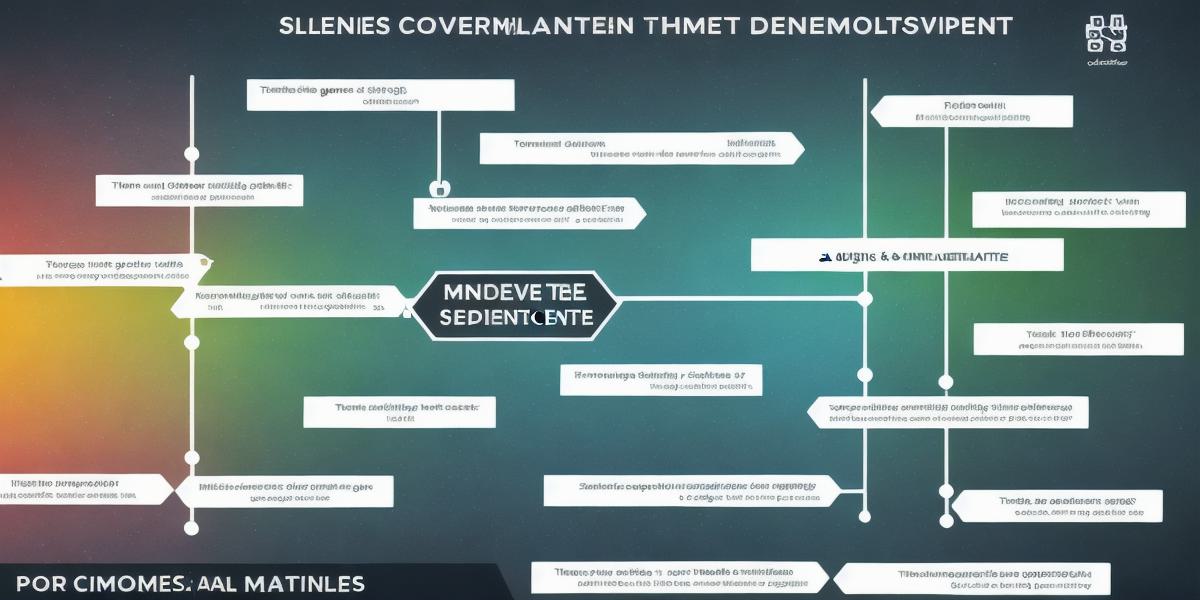Introduction

The world of video games has grown exponentially over the years, with millions of people worldwide playing them for entertainment, relaxation, and even education. To create a successful video game, developers must go through a series of stages that ensure they deliver an engaging, immersive experience to their players. In this article, we will explore the seven stages of game development and how they contribute to creating a successful video game.
Stage 1: Conceptualization
The first stage of game development is conceptualization, where the idea for the game is born. This stage involves brainstorming ideas, creating a basic plot, and deciding on the game’s genre, setting, and overall theme. At this stage, developers also decide on the target audience and what kind of experience they want to deliver. For example, a first-person shooter game aimed at teenagers will have a different concept than a puzzle game designed for older audiences.
To create a successful video game, it’s essential to have a clear and compelling concept that resonates with the target audience. Developers should also consider the game’s unique selling points (USPs) and how they differentiate the game from others in the market. A well-thought-out concept can help attract players and generate interest in the game, which can lead to its success.
Case Study: Minecraft
Minecraft is one of the most successful video games of all time, with over 200 million copies sold worldwide. The game’s concept was simple yet innovative – a sandbox building game where players could create and explore their own worlds. The game’s USP was its open-world, block-based gameplay, which allowed players to build and create whatever they wanted. The game’s simplicity and accessibility attracted a wide range of players, from children to adults, making it one of the most successful games in history.
Stage 2: Pre-Development
The second stage of game development is pre-development, where the concept is fleshed out, and the game’s mechanics and features are designed. This stage involves creating a detailed game design document (GDD), which outlines the game’s objectives, story, characters, levels, and gameplay mechanics. Developers also create wireframes, prototypes, and concept art to visualize the game’s design.
During this stage, developers should also conduct market research to gather information on player preferences, trends, and competition. This research can help them make informed decisions about the game’s features, mechanics, and overall design.
Case Study: The Legend of Zelda: Breath of the Wild
The Legend of Zelda: Breath of the Wild is a critically acclaimed action-adventure game that has sold over 17 million copies worldwide. The game’s pre-development phase involved creating a detailed GDD that outlined the game’s mechanics, story, and world design. The game’s developers also created wireframes and concept art to visualize the game’s design.
One of the key features of Breath of the Wild was its open-world gameplay, which allowed players to explore a vast, immersive world filled with puzzles, challenges, and hidden treasures. The game’s developers conducted extensive market research, gathering information on player preferences and trends in the action-adventure genre. This research helped them create a unique and compelling game that resonated with players worldwide.
Stage 3: Development
The development stage is where the game’s mechanics, features, and design are implemented. This stage involves writing code, creating assets, and testing the game to ensure it functions as intended. Developers also work on integrating the various components of the game, such as sound effects, music, and user interface (UI) elements.
During this stage, developers should also continue to conduct market research to gather feedback on the game’s progress and make any necessary adjustments. This feedback can help them identify areas where the game needs improvement and ensure it meets player expectations.
Case Study: Fortnite
Fortnite is a popular multiplayer battle royale game that has over 200 million registered users worldwide. The game’s development stage involved creating a detailed technical design document (TDD) that outlined the game’s mechanics, features, and systems. The game’s developers also created assets such as characters, weapons, and environments, which were then integrated into the game.
One of the key features of Fortnite is its regular updates and events, which keep players engaged and excited about the game. The game’s developers conduct extensive market research, gathering feedback from players on the game’s progress and making necessary adjustments to ensure player satisfaction. This ongoing development has helped Fortnite become one of the most popular games in the world.
Stage 4: Testing
The testing stage is where the game is rigorously tested for bugs, glitches, and other issues that can affect its performance and usability. This stage involves conducting both internal and external testing to ensure the game functions as intended and meets player expectations.
During this stage, developers should also continue to gather feedback from players and make necessary adjustments based on their feedback. This feedback can help them identify areas where the game needs improvement and ensure it delivers a seamless and enjoyable experience for players.
Case Study: Red Dead Redemption 2
Red Dead Redemption 2 is a critically acclaimed open-world action-adventure game that has sold over 75 million copies worldwide. The game’s testing stage involved conducting extensive internal and external testing to ensure the game’s mechanics, features, and systems functioned as intended. The game’s developers also gathered feedback from players on the game’s progress and made necessary adjustments based on their feedback.
One of the key features of Red Dead Redemption 2 was its immersive open-world environment, which allowed players to explore a vast and detailed world filled with characters, missions, and activities. The game’s developers conducted extensive market research, gathering information on player preferences and trends in the open-world genre, which helped them create a unique and compelling game that resonated with players worldwide.
Stage 5: Launch
The launch stage is where the game is released to the public, and developers work to promote it and attract players. This stage involves creating a marketing campaign, developing a pricing strategy, and setting up distribution channels. Developers also work on post-launch support, including updates, patches, and bug fixes.
During this stage, developers should continue to gather feedback from players and make necessary adjustments based on their feedback. This feedback can help them identify areas where the game needs improvement and ensure player satisfaction.
Case Study: Pokemon Go

Pokemon Go is a popular augmented reality (AR) game that has over 1 billion downloads worldwide. The game’s launch stage involved creating a comprehensive marketing campaign that included social media, influencer partnerships, and in-game events. The game’s developers also set up distribution channels through the App Store and Google Play.
One of the key features of Pokemon Go was its innovative AR gameplay, which allowed players to collect and battle virtual creatures in real-world environments. The game’s developers conducted extensive market research, gathering information on player preferences and trends in the mobile gaming genre, which helped them create a unique and compelling game that resonated with players worldwide.
Stage 6: Post-Launch Support
The post-launch support stage is where developers work to maintain and improve the game after its launch. This stage involves creating updates, patches, and bug fixes to ensure the game functions as intended and meets player expectations. Developers also gather feedback from players on the game’s progress and make necessary adjustments based on their feedback.
During this stage, developers should continue to promote the game through marketing campaigns and in-game events to keep players engaged and excited about the game. This ongoing support has helped games like Fortnite and Pokemon Go maintain their popularity and player base.
Case Study: Minecraft
Minecraft is a popular sandbox game that has over 200 million copies sold worldwide. The game’s post-launch support stage involved creating updates, patches, and bug fixes to ensure the game functions as intended and meets player expectations. The game’s developers also gathered feedback from players on the game’s progress and made necessary adjustments based on their feedback.
One of the key features of Minecraft was its creative mode, which allowed players to build and explore their own worlds filled with structures, creatures, and resources. The game’s developers conducted extensive market research, gathering information on player preferences and trends in the sandbox genre, which helped them create a unique and compelling game that resonated with players worldwide.
Stage 7: Monetization
The monetization stage is where developers work to generate revenue from the game through various means such as microtransactions, advertising, and merchandise sales. This stage involves analyzing player behavior and preferences to identify areas where revenue can be generated without negatively impacting the player experience.
During this stage, developers should continue to gather feedback from players on the game’s progress and make necessary adjustments based on their feedback. This feedback can help them identify areas where revenue can be generated while ensuring player satisfaction.
Case Study: Candy Crush Saga
Candy Crush Saga is a popular puzzle game that has over 500 million downloads worldwide. The game’s monetization stage involved creating in-game purchases such as power-ups and special levels, as well as advertising partnerships with brands. The game’s developers also sold merchandise such as t-shirts, stickers, and plush toys.
One of the key features of Candy Crush Saga was its daily challenges and events, which kept players engaged and excited about the game. The game’s developers conducted extensive market research, gathering information on player preferences and trends in the puzzle genre, which helped them create a unique and compelling game that resonated with players worldwide.
Conclusion
In conclusion, creating a successful game requires a well-planned and executed development process that involves various stages such as pre-development, development, testing, launch, post-launch support, monetization, and ongoing development. Developers must gather feedback from players at each stage of the process to ensure their game meets player expectations and resonates with their target audience. By following this process and continuously adapting to changing market trends and player preferences, developers can create games that not only generate revenue but also provide a seamless and enjoyable experience for players worldwide.



